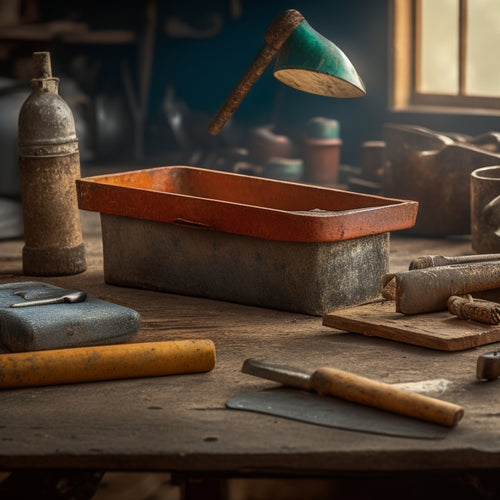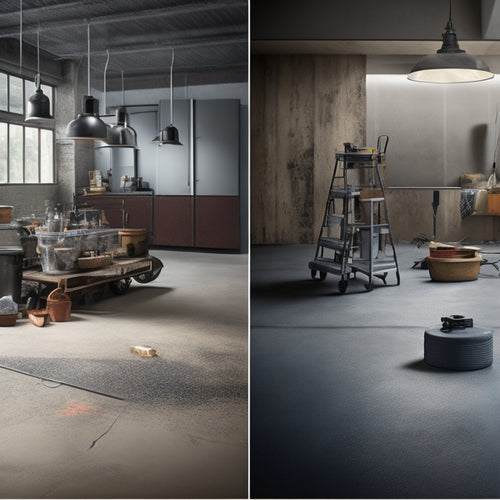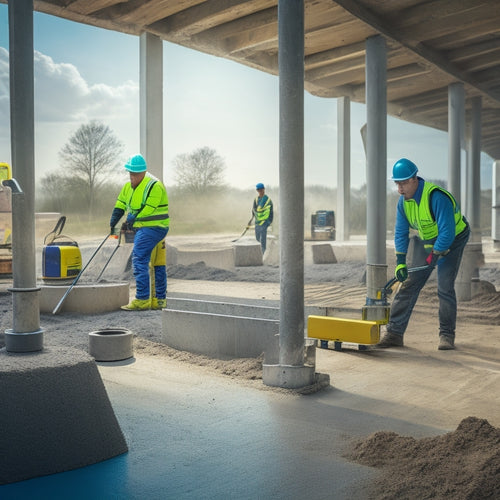
Top 7 Sealing Tools for Your Concrete Walls
Share
When sealing your concrete walls, having the right tools is vital for a professional-quality finish. You'll need a concrete sealant, caulk gun, paint roller, brushes, and trowel for application and smoothing. Additionally, consider a sealant injector for cracks, roller extensions for high walls, and applicator brushes for corners. Don't forget essential cleaning tools like dusting brushes, HEPA filter vacuum cleaners, and microfiber cloths for surface preparation. Finally, prioritize safety with protective gear like safety goggles, chemical gloves, and dust masks. With these top 7 sealing tools, you'll be well-equipped to tackle the job - and getting started will reveal the details that make all the difference.
Key Takeaways
• Essential sealing tools include concrete sealant, caulking gun, paint roller, brushes, and trowel for precise application and even coverage.
• Choosing the right sealant gun ensures compatibility, adjustable pressure, comfort, durability, and a professional-quality finish.
• Selecting the correct sprayer for thick coatings, such as airless, HVLP, or texture sprayers, depends on coating viscosity and desired finish.
• Applicator brushes with angled or curved heads and varying bristle lengths and stiffness provide precise control for corners and edges.
• Sealant injectors for cracks offer precise control, deep penetration, and time-efficient application for strong bonding and effective crack stabilization.
Choosing the Right Sealant Gun
You'll need a reliable sealant gun to efficiently apply sealants to your concrete walls, and selecting the right one involves pondering factors such as sealant type, application pressure, and gun design.
When it comes to sealant types, you'll need to choose a gun that's compatible with the specific type you're using, whether it's acrylic, silicone, or polyurethane. Each type has its own unique requirements, so make certain the gun you choose can handle the viscosity and flow rate of your chosen sealant.
Gun features are also essential to contemplate. Look for a gun with adjustable pressure control, which will allow you to fine-tune the application pressure to suit your specific needs. A gun with a comfortable grip and balanced design will reduce fatigue during extended use.
Additionally, think about a gun with a durable, corrosion-resistant construction that can withstand the rigors of heavy use. By taking these factors into account, you'll be able to select a sealant gun that meets your specific needs and guarantees a professional-quality finish.
Best Sprayers for Thick Coatings
When applying thick coatings to concrete walls, selecting the right sprayer is essential to achieve an even, consistent finish. You'll want a sprayer that can handle the viscosity of the coating and provide the necessary pressure to achieve the desired thickness. There are several sprayer types to evaluate, each suited for specific coating techniques.
| Sprayer Type | Coating Technique |
|---|---|
| Airless Sprayers | Suitable for high-build epoxy and polyurethane coatings, providing a smooth, even finish. |
| HVLP (High Volume, Low Pressure) Sprayers | Ideal for applying thin, uniform coats of acrylic and latex-based coatings. |
| Texture Sprayers | Designed for applying heavy, textured coatings, such as stucco and elastomeric finishes. |
When choosing a sprayer, reflect on the coating's viscosity, the desired finish, and the surface area to be covered. By selecting the right sprayer for your project, you'll achieve a professional-looking finish and guarantee a long-lasting seal. Remember to always follow the manufacturer's instructions and take necessary safety precautions when working with sprayers and coatings.
Applicator Brushes for Corners
Corners and edges often require special attention, and applicator brushes are the ideal tools for guaranteeing a seamless seal in these areas.
When it comes to corner application techniques, you'll want to choose a brush that allows for precise control and flexibility. Look for brushes with angled or curved heads, which enable you to reach into tight spaces and navigate complex corners with ease.
As for brush material options, you'll typically have a choice between natural bristle, nylon, or polyester. Natural bristle brushes are ideal for oil-based coatings, while nylon and polyester brushes are better suited for water-based or epoxy-based coatings. Consider the type of sealant you're working with and choose a brush material that's compatible.
When selecting an applicator brush, also consider the bristle length and stiffness. Softer bristles are better for delicate surfaces, while stiffer bristles provide more aggressive application.
Roller Extensions for High Walls
Reaching high walls with a standard roller is often impractical, so it's vital to use roller extensions that can be securely attached to your roller handle. This allows you to apply sealant to those hard-to-reach areas with ease.
These extensions enable you to maintain effective roller techniques, guaranteeing consistent wall coverage even on high walls. When selecting a roller extension, consider the length and material of the extension, as well as the type of sealant you're using. A longer extension may be necessary for extremely high walls, while a shorter extension may be more suitable for lower walls. Additionally, consider the weight and balance of the extension, as this can affect your ability to apply even pressure and maintain control.
To achieve the best wall coverage, it's important to adjust your roller technique according to the extension's length and the wall's surface. For example, you may need to use slower, more deliberate strokes on higher walls to maintain control and prevent drips.
Sealant Injectors for Cracks
By injecting sealant directly into cracks, you can effectively fill and seal even the narrowest openings in your concrete walls. This method is particularly useful for epoxy repairs, where precision is key. Sealant injectors are designed to deliver a precise amount of sealant into the crack, ensuring a strong bond between the sealant and the concrete.
Here are some key benefits of using sealant injectors for crack stabilization:
-
Precise control: Injectors allow you to control the amount of sealant dispensed, reducing waste and ensuring a clean, mess-free application.
-
Deep penetration: Sealant injectors can reach deep into the crack, filling even the smallest voids and providing a strong, lasting bond.
-
Flexibility: Many injectors come with interchangeable tips, allowing you to adapt to different crack sizes and shapes.
- Efficient: Sealant injectors can save you time and effort compared to traditional application methods, making them a valuable addition to your toolkit.
Cleaning Tools for Surface Prep
When preparing a concrete wall for sealing, you'll need to guarantee the surface is clean and free of debris.
You'll start by dusting the concrete surface to remove any loose particles, and then move on to removing old coatings that may be interfering with the sealant's adhesion.
Dusting Concrete Surfaces
You'll need to remove any loose debris or dust from the concrete surface using specialized cleaning tools to guarantee a strong bond between the old concrete and the new sealant. Dusting concrete surfaces is a vital step in surface preparation, ensuring a strong and long-lasting seal.
To achieve this, you'll need to employ effective dust prevention techniques and surface cleaning methods.
Some essential tools for dusting concrete surfaces include:
-
Brooms or scrub brushes to remove loose debris and dust
-
Vacuum cleaners with HEPA filters to capture fine dust particles
-
Damp mops or wet vacuums to reduce dust clouds
- Microfiber cloths or specialized dusting pads for fine-tuning the surface
Removing Old Coatings
Before applying a new sealant, old coatings, including sealers, paints, and epoxies, must be thoroughly removed from the concrete surface to guarantee a strong bond. You'll need to employ effective coating removal techniques to secure a successful sealant application.
You can use mechanical methods, such as scraping, grinding, or sanding, to remove old coatings. These methods are effective for removing thick, hardened coatings.
Chemical stripping is another option, where you apply a solvent-based solution to break down the old coating. This method is ideal for removing multiple layers of coatings. Additionally, you can use a combination of both mechanical and chemical methods for the best results.
Regardless of the method you choose, it's crucial to follow proper surface preparation methods to make sure the surface is clean, dry, and free of contaminants. This will help create a strong bond between the concrete and the new sealant.
Remember to always wear protective gear, including gloves, goggles, and a mask, when removing old coatings to avoid exposure to hazardous materials.
Protective Gear for Safe Use
Wearing protective gear is essential to assure your safety while using sealing tools for concrete walls, as the process can generate harmful dust and debris.
You don't want to risk your health by inhaling toxic particles or getting chemical splashes in your eyes. To assure a safe and successful sealing process, you need to wear the right gear.
Here are the must-haves for your protective arsenal:
-
Safety goggles: Protect your eyes from chemical splashes and flying debris.
-
Chemical gloves: Prevent skin irritation and chemical burns with gloves designed for handling harsh substances.
-
Dust mask: Breathe easy with a mask that filters out dust and particles.
- Long-sleeved clothing: Cover your skin to prevent irritation and exposure to harsh chemicals.
Frequently Asked Questions
Can I Use a Sealant Gun for Both Low and High-Pressure Applications?
When selecting a sealant gun, you're likely wondering if it can handle both low and high-pressure applications.
The answer lies in the gun's versatility. Look for a gun that offers adjustable pressure control, allowing you to fine-tune your pressure application techniques.
This feature guarantees you can tackle a range of tasks, from delicate, low-pressure sealing to more demanding, high-pressure applications.
Are All Sealant Sprayers Suitable for Epoxy-Based Coatings?
Imagine a puzzle with mismatched pieces - that's what happens when you force an incompatible sealant sprayer to work with epoxy-based coatings.
Not all sprayers are created equal, and their compatibility depends on the coating type.
You'll need a sprayer specifically designed for epoxy-based coatings, as they require a unique combination of pressure and flow rate to guarantee a smooth, even application.
Don't risk a faulty seal - choose the right sprayer for the job.
How Often Should I Clean My Applicator Brushes to Maintain Quality?
You should clean your applicator brushes regularly to maintain quality and extend their lifespan.
For ideal brush maintenance, wash them with soap and water after each use, and let them air dry.
This prevents epoxy-based coating residue from building up and compromising applicator longevity.
Can I Use a Roller Extension With a Standard Paint Roller?
You think you're a rebel, using a roller extension with a standard paint roller, don't you?
Well, surprisingly, it's not a bad idea! In fact, a roller extension can be a game-changer, offering benefits like increased reach and reduced fatigue.
And the good news is, most standard paint rollers are compatible with extensions.
Are Sealant Injectors Effective for Filling Deep Cracks in Concrete Walls?
When dealing with deep cracks in concrete walls, you're probably wondering if sealant injectors are up to the task. The answer is yes, but it depends on the crack depth and sealant type.
For cracks over 1/4 inch deep, injectors can effectively fill the void with a low-viscosity sealant, like polyurethane or epoxy.
However, for shallower cracks, a surface-applied sealant might be more suitable.
You'll want to choose the right sealant and tool combo to guarantee a successful repair.
Conclusion
Now that you've got the top 7 sealing tools for your concrete walls, it's time to gear up and get to work.
Imagine your walls as a fortress, and these tools as the armor that shields them from the elements.
With the right sealant gun, sprayers, brushes, roller extensions, injectors, cleaning tools, and protective gear, you'll be able to fortify your walls and keep them strong for years to come.
Related Posts
-

Smart Guide to Buying Used Concrete Hand Tools
You're about to buy used concrete hand tools, and you need to get it right. Dedicate time to identify the tools you n...
-

Top Tools for Revamping Old Concrete Floors
You'll need a range of tools to revamp your old concrete floor, starting with epoxy, acrylic, or polyurethane paint, ...
-

What Tools Ensure Precise Concrete Leveling Results
You need a range of specialized tools to achieve precise concrete leveling results. Laser leveling instruments provid...


